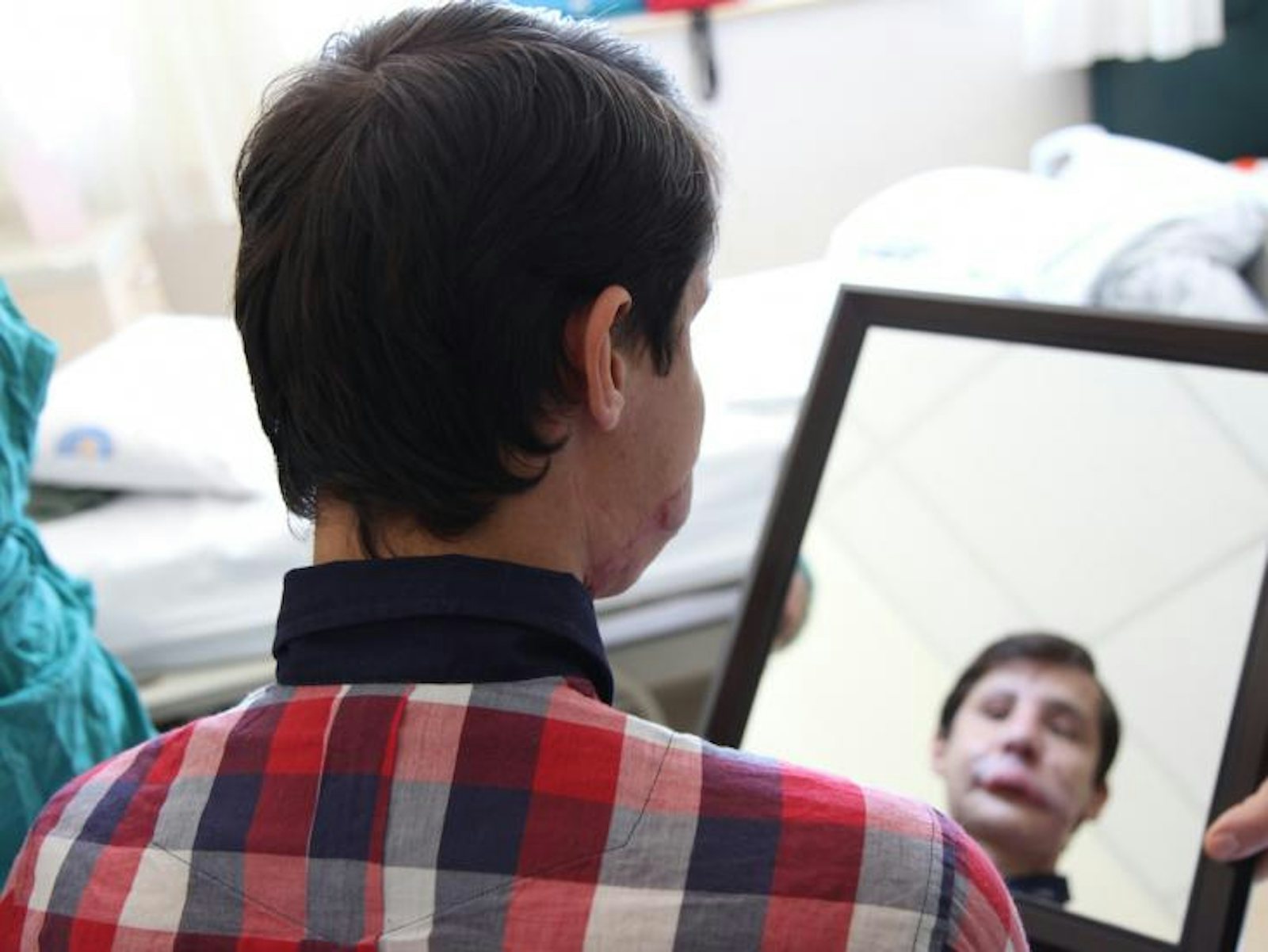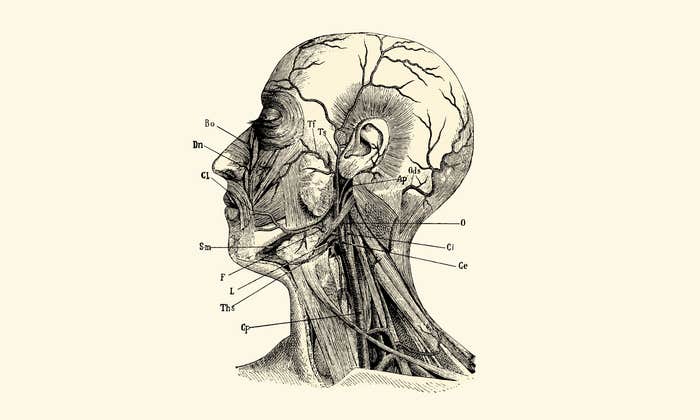Just last month, Carmen Blandin had a remarkable dream. In it she saw, for the first time, not her old face in the mirror—the one she had for the first 38 years of her life—but the new face she received in a transplant three years ago. “I actually saw me with my new face,” she says. “Finally.” In the dream, she was smiling. Carmen became severely disfigured one evening in 2007, at her home in rural Vermont, when her estranged husband doused her with industrial strength lye while she lay in bed. She still identifies more with her original face, she says, but that doesn’t mean she wants it back.
That Carmen has, in some measure, moved on from her old identity by eschewing any desire for her old face is interesting—and counter-intuitive—because the human face has long been considered a kind of synecdoche for the self. It’s apparent in our language—“to lose face,” “two-faced”—and in our stories. Oscar Wilde’s Dorian Gray famously pledges his soul in exchange for eternal youth and beauty, only to find that his growing inner ugliness reveals itself in hideous facial deformities in a portrait hidden in the attic. In Kobo Abe’s The Face of Another, later adapted to film, a scientist creates a new face for himself following a terrible accident, and begins to live as a new man. And then there is, of course, Dr. Jekyll and Mr. Hyde.
But how our faces link to our personal identity isn’t just a fanciful plot device; the connection turns out to be as deep and as consequential as any of these stories might suggest. Humans are wired from a very young age to treat faces and face-like visual patterns as special perceptual objects, and autism research suggests that this facial perceptivity plays a role in psychological development and language acquisition—no other category of objects has so many cells dedicated to its perception.
So it’s no surprise that, just over a decade ago, many thought face transplantation fantastical. The procedure put otherwise healthy individuals at risk not only for serious infection and even death, brought on by heavy doses of immunosuppressant drugs, but also—some surgeons and psychologists feared—severe psychosocial crisis and identity confusion. These fears were further stoked by studies showing that some organ transplant recipients suffer from a condition called “depersonalization,” also known as Frankenstein Syndrome, characterized by fears that the dead organ donor’s identity has become part of one’s own. Can you imagine looking in the mirror and finding someone else’s face staring back?
Seeing areas of the brain corresponding to facial motor function light up, says Blitz, “helps them internalize that this is their own face.”
In 2009, Bohdan Pomahac, Carmen’s surgeon at Brigham & Women’s Hospital, assumed it would be deeply unsettling for his first face-transplant patient to see his new face. Pomahac and his team of doctors took great care orchestrating the patient’s first viewing—they made sure the patient couldn’t see himself for weeks, fearing the worst. Yet, when it was time to see himself, he was perfectly calm—so calm, in fact, that Pomahac let his guard down a little bit for the reveal with his next patient, and still more with the next. In the end, he says, he found that none of the five transplant patients he worked with had any trouble seeing their new faces at all. Indeed, with the exception of three patients who died, early evidence suggests that face transplant recipients are adapting well, according to a review of the first 28 of such patients, published in 2014 in The Lancet. (That review relied in part on short-term, incomplete, or non-standardized data as well as media reports. There aren’t, as of yet, any large scale studies because the procedure is so new.)
What’s more, it turns out that getting a new face may be less difficult psychologically than adapting to new hands, say surgeons and psychologists who have worked with both kinds of patients. One critical difference is that your hands are within sight throughout the day, while your face is only visible with a mirror. (It makes sense; visibility plays an important role in body perception; phantom limb pain, for example, has been cured with mirrors.) Unlike a hand transplant, a face transplant also ultimately creates a kind of hybrid of old and new: The tissues of the donor face mold themselves to the underlying facial architecture of the recipient—bone, muscle, remaining tissues—in a way that hands don’t with the rest of the forearm. Also, the face tends to connect with the nervous system more quickly than the hands—regaining sensation in 3 months and function in 6 to 8 months, versus a couple of years for hands, says Aileen Blitz, a clinical psychologist and adjunct assistant professor of plastic surgery at NYU Langone Medical Center.
Due to their facial disfigurements, potential face transplant recipients are typically unable to do the most basic things: socializing, eating, drinking, seeing, smelling, or breathing normally. Soon after their transplants, though, many of these functions are restored, and many of the patients begin to lead normal lives. The key to this success rate has nothing to do with surgery, according to surgeons and psychologists: It’s patient selection.
Potential transplant recipients undergo rigorous psychiatric and psychological screening because doctors want individuals who are stable, motivated, socially supported, and who seem likely to comply with the intensive treatment and post-operation rehabilitation, which will continue for the rest of their lives. At NYU Langone, psychological follow-up is mandatory, says Blitz. As part of rehab, doctors there require patients to watch fMRI scans of their brains while they exercise new face muscles. Seeing areas of the brain corresponding to facial motor function light up, says Blitz, “helps them internalize that this is their own face.” Assessments suggest that the prevalence of depression and verbal abuse decreases post-op, while body image and sense of self improve. “Pretty much everyone who would look at these patients would agree it’s not quite a human face,” says Pomahac. “But then you compare to what they started with, and there’s an exponential improvement.”
A donor face, because it is a hybrid, is not typically recognizable by the donor family when it’s transplanted on another person—but that doesn’t stop some from seeing their deceased loved ones live on, in a way, in another person. Marinda Righter—the daughter of Cheryl Righter, Carmen’s donor—said she felt overjoyed upon meeting Carmen. She got to, she says, “feel my mother’s skin again” and “to see my mother’s freckles.” For Carmen, this has been comforting, as well. “I have a lot of appreciation and gratitude for this gift,” she says. “Spiritually she’s with me.” Today, Carmen is a motivational speaker, has written one book about overcoming her disfigurement, and is writing another about her face transplant. A striped red scarf that used to belong to Cheryl hangs on her bedroom’s doorknob.
In the end, the key to a successful rehabilitation may be a kind of cognitive dissonance: the ability to see a new face as your own while at the same time feeling a certain kinship with its former owner—a version of Frankenstein Syndrome, but happier.
Kristen French is a freelance science journalist and editor in Brooklyn. Her news and features stories have appeared in New York magazine, The Verge, Popular Mechanics, Al Jazeera America, Guernica and OnEarth.


























